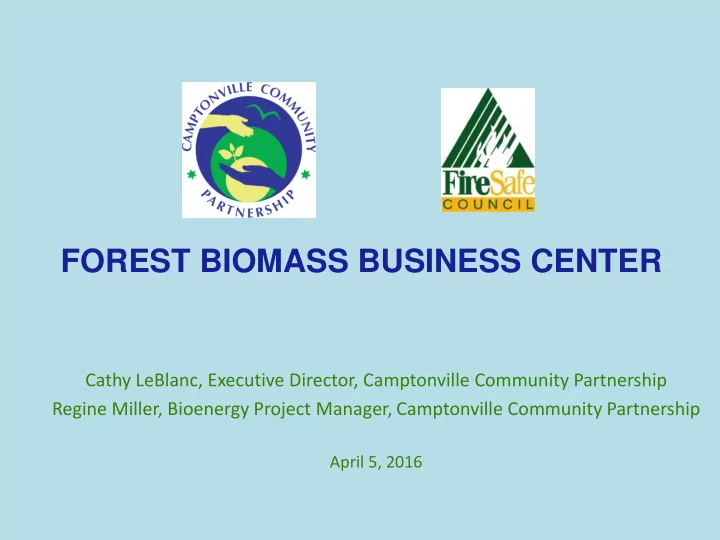

FOREST BIOMASS BUSINESS CENTER Cathy LeBlanc, Executive Director, Camptonville Community Partnership Regine Miller, Bioenergy Project Manager, Camptonville Community Partnership April 5, 2016
PROJECT GOALS • Build viable model for biomass utilization • Create sustainable local employment • Promote a fire safe community • Improve regional air quality • Enhance forest and watershed health • Produce renewable energy • Revitalize the Celestial Valley mill site
PROJECT LOCATION PROJECT LOCATION Proposed bioenergy facility Highway 49
PROJECT CONCEPT • Small scale (2.7-3 MW) • Combined heat & power (CHP) • Direct combustion boiler steam turbine technology • Aim to use 100% forest biomass from a mix of suppliers From “Combined Heat and Power and Pellets”, John Swaan, Magnolia BioEnergy
WHO WILL USE THE ELECTRICITY AND HEAT PRODUCED? • Power Purchase Agreement with PG&E • Co-located business(es): – Seasoned firewood – Heat-treated pallets – Wood pellets – Pet bedding – Poles – Greenhouse – Brewery
PROJECT HISTORY • 2010: Yuba Foothills Biomass Feasibility Study • 2010: CCP and the Yuba Watershed Protection and Fire Safe Council • 2013-14: National Forest Foundation Grant – Outreach and capacity building – Formation of Steering Committee – Economic Development Plan
PROJECT HISTORY CONT’D • 2014-2015: Sierra Nevada Conservancy Grant ‒ Site specific feasibility study ‒ Outreach and education • 2014-2015: Pacific CHP Technical Assistance Partnerships ‒ Evaluation of potential co-located businesses ‒ Third party review of feasibility study
CURRENT PROJECT WORK • 2014- 2016: Sierra Institute’s Rural Community Development Initiative Grant ‒ Technical assistance • 2015-2017: USFS Wood Innovations Grant – Site plan – Conditional Use Permit/CEQA – System Impact Study • 2015-2016: Yuba County Water Agency − Ownership model and project developer selection pre-work − Capacity building
NEXT STEPS • NFF Community Capacity Land Stewardship grant − Regional outreach and education − Community-based process to select ownership model and project developer − Build regional capacity for co-located businesses • Prepare to enter the BioMat queue for feed-in tariff auction ‒ Site control ‒ SIS ‒ Project developer • Consider an EPIC grant application • Explore USDA financing • Secure co-located businesses • Complete preliminary engineering • Power purchase agreement
SCHEDULE (ha, ha) • Now- Nov 2016. Site plan, permitting, SIS • Now-Nov 2016. Establish ownership model/entity • Now-? Explore USDA funding • April-May 2016. EPIC grant application • May 2016-Jan 2017. Select project developer • June 2016-Oct 2017. Build capacity for and secure co-located businesses • Nov 2016-Jan 2017. Permits (air, water, building) • Jan-March 2017. FiT auction/PPA • Aug 2017. Finalize fuel contracts • Jan 2018-Dec 2018. Facility construction
PROJECT PARTNERS & SUPPPORTERS • • Yuba County Watershed Protection Camptonville Community and Fire Safe Council • Camptonville School • University of California Cooperative • Camptonville Community Services Extension District • USFS Tahoe NF & Plumas NF • Yuba County BOS • Sierra Nevada Conservancy • Yuba-Sutter Economic • National Forest Foundation Development Corporation • • Center for Sustainable Energy Yuba County Water Agency • • Sierra Institute for Community & Nevada County Biomass Task Force Environment • Fire Safe Council of Nevada County • Statewide Wood Energy Team • Private timber industry (SWET) • Bear-Yuba Land Trust • Biomass Working Group (BWG) • South Yuba River Citizens League • UC Davis - California Biomass • Senator Jim Nielsen Collaborative
THANK YOU http://sites.theccp.org/fbbc/ Contact Camptonville Community Partnership: cathy@theccp.org regine@theccp.org (530) 288-9355 P.O. Box 218, Camptonville, CA 95922
Recommend
More recommend